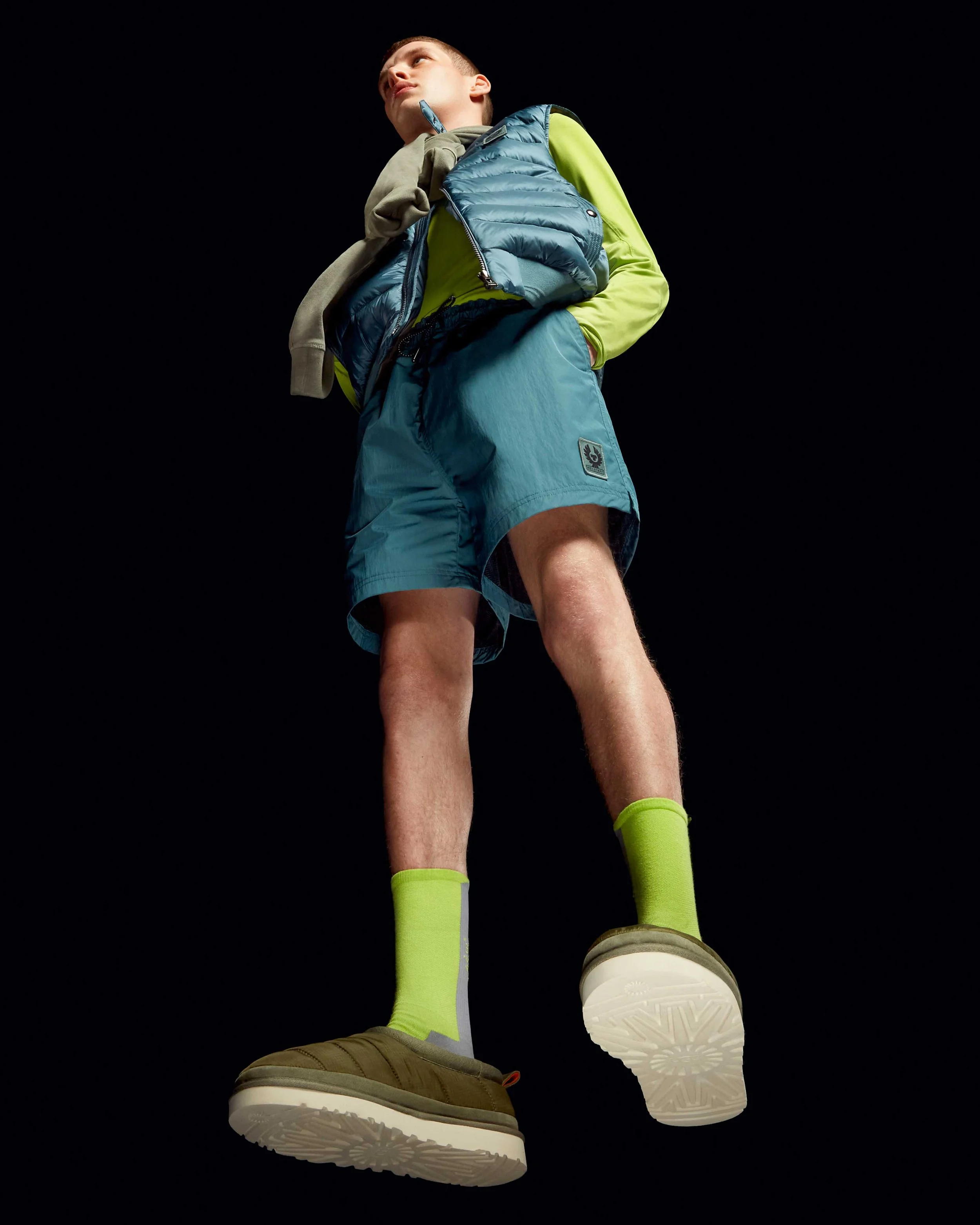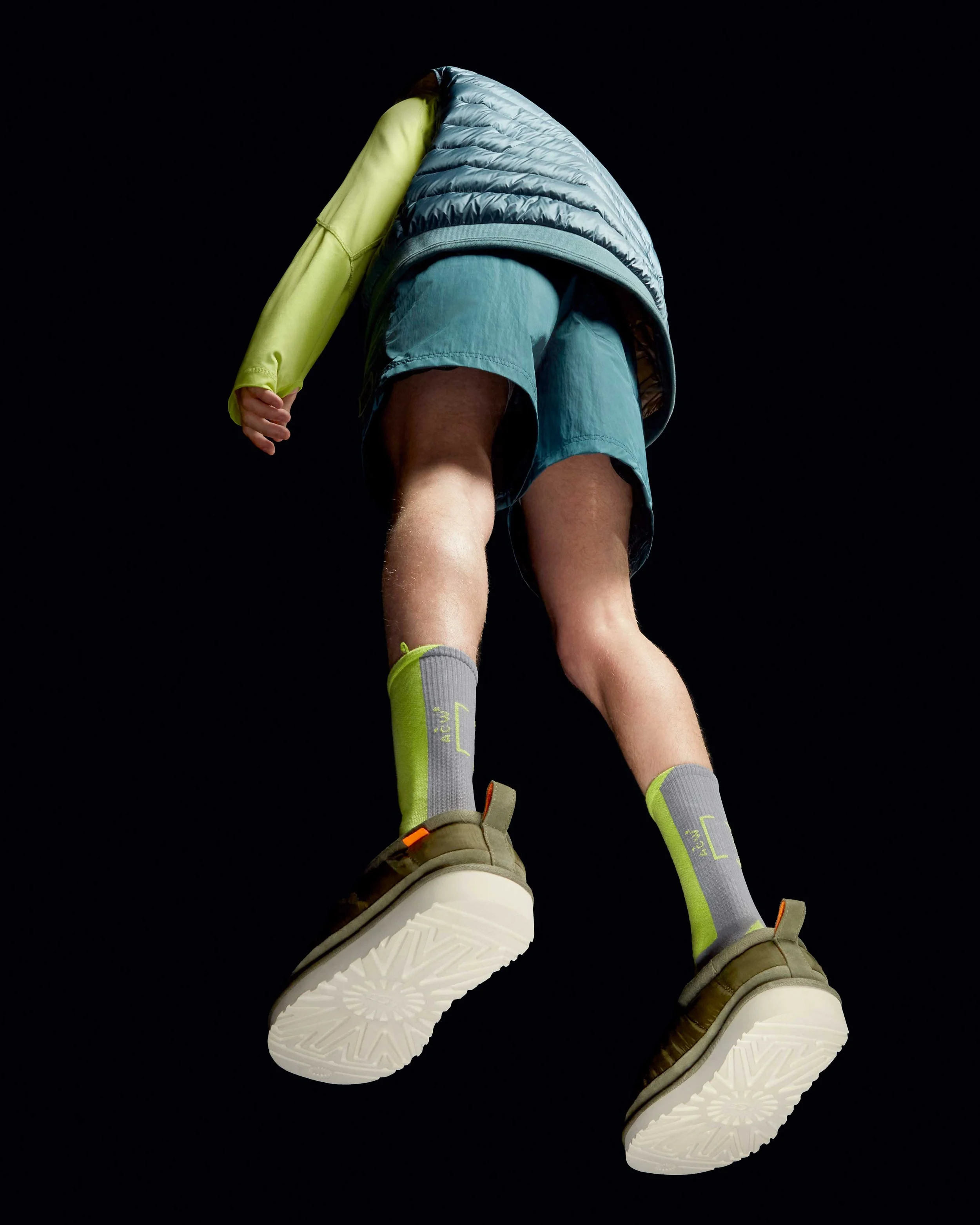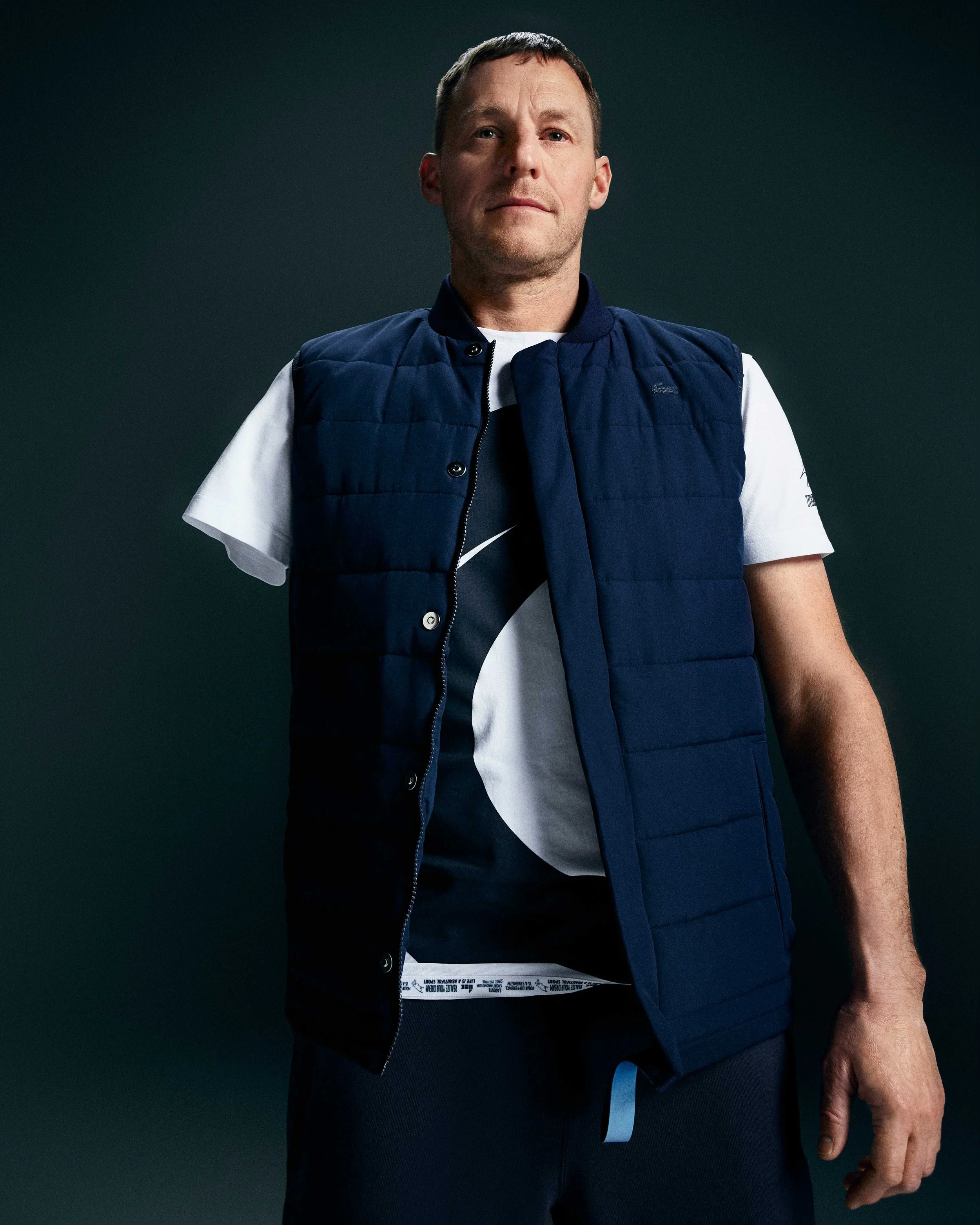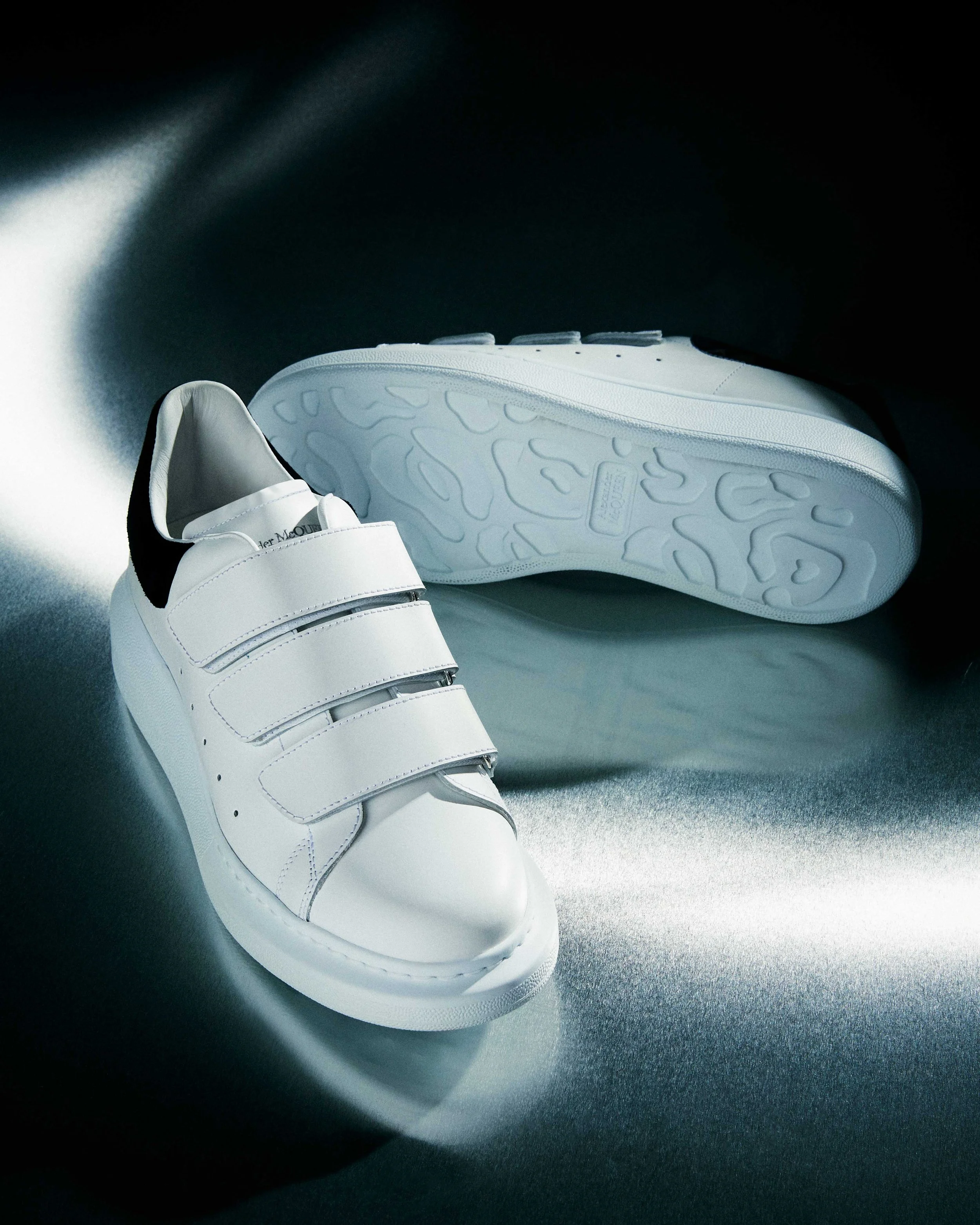circlezeroeight
Alloy Worldwide worked closely with the production team on this shoot to ensure the accessibility requirements and reasonable adjustments of talent and crew were accounted for. Liaising directly with the executive producer, Alloy aided the smooth running of shoot day - making sure the studio was fully wheelchair accessible; changing how records were kept with production sheets and took a central role in briefing staff and crew to foster a welcoming working environment on set.
Model and disabilities advocate RYAN ZAMAN speaks with swimmer and quadruple amputee THÉO CURIN on his new collection for LACOSTE and how adaptive sportswear is invaluable to all.
The term ‘adaptive’ when it comes to clothing seems like a relatively new one, especially when we think about wider society’s awareness of what it is and what it means. Although, thinking back, my first experience of adaptive clothing was very early on – through footwear – even though we didn’t really call it that back then. One of my first memories is having my feet casted in plaster of paris for my first set of Ankle Foot Orthotics (AFOs) – these are moulded plastic splints to help keep your ankles in the right position, which are then placed inside Orthopaedic shoes. Not very fashionable or appealing for sure, so my Orthotist, Howard, got around my four-year-old brain’s protest by appealing to my inner petrol head, putting a pattern of race cars and chequered flags on the splints. All of a sudden, the annoyance of wearing them all day every day, and a different pair at night (which went all the way up the back of my calf – they had fish on by the way), was slightly softened. That effect didn’t last 14 years though, unfortunately for him.
Throughout school, I was very aware of my shoes, and how they were different to everyone else’s – how it was clear they served a medical purpose above all else. There was nothing out there in the mainstream market that was suitable for what I needed. My Mum even spent hours cutting and sewing to adapt a pair of black PE pumps when I was six or seven, so they would fit over my splints. At the time, I gave them one look and said I wouldn’t wear them because they were different, and they showed my splints – I couldn’t hide them wearing shorts. It’s only now that I truly appreciate the hours my Mum put into that pair of pumps, as she was trying to help me out by making the same shoes everyone else was wearing, work for me (sorry Mum!).
Until I was about 16, I wore Velcros most of the time (apart from weekends). If you look up ‘velcro trainers’ online, up comes a million articles about how uncool they are – probably because of the medical associations that people think of. Hopefully we can go some way to change that – if velcro means the trainers someone wants to wear are accessible for them and easy to wear, who are others to judge?
Fast forward to present day when disabled talent and an inclusive team behind the scenes have collaborated to create the images which accompany this piece. Everyone involved in this shoot got a brief glimpse of the inconvenience experienced by a lot of people with physical disabilities who may struggle to access or navigate public transport independently. Shoot day for us just so happened to coincide with the whole of the London Underground network being on strike.
Our aim with this story was to change people’s perception as to what it means for a piece of clothing to be ‘adaptive’ and ‘accessible.’ A lot of things that disabled people focus on when buying sportswear, beyond aesthetics, are very similar. Many brands are already producing clothing with adaptive elements, but interestingly the number of brands that view these things as adaptive for a disability is markedly low.
Clothes are important to all of us. They are a vital form of self-expression – even if you don’t care about clothes, or wear the same thing every day, this is a conscious decision of how you want to present yourself to the world around you. Clothes also have an important role in terms of practicality, too – when it comes to sportswear, what you chose to wear can have a profound effect on your ability to keep warm, keep cool, keep dry; how much protection your skin has against bumps and scrapes, or how much you are able to carry. Arguably, for both sportswear customers and brands, all is won (or lost) with how well innovation is executed in relation to these practical elements. Customers who undoubtedly have the keenest eye when it comes to features integrated into a garment are disabled people.
Disabled people are also likely to be wearing some kind of sportswear most of the time. How can that be? I hear you ask. Surely most physically disabled people aren’t that physically active?
True, most people with disabilities are not Paralympians. However, what sportswear means to us – to everyone – has changed a lot over the past few decades. The meaning of sportswear now spans far more than the deeply-specialist and performance-oriented connotations it began with in the 1960s and 70s. Sportswear is now synonymous with comfort and convenience, as well as all the sports-specific links. And whilst in the past it has been intrinsically linked to strong and defined subcultural movements, its meaning has never been more universal than now.
One overall message that we would like to send to brands and manufacturers is that if a garment includes one or more adaptive design elements, it is adaptive. Every design choice has a factor in a sportswear shoe or garment’s convenience and usability – this is important for everyone – disabled or not. Good design is good design.
This mindset is shared by Lacoste, which has recently collaborated with French swimmer Théo Curin to create a capsule collection of products with adaptive elements, which are accessible and convenient to use for everyone. Curin is a quadruple amputee. At six years old, he was diagnosed with Meningitis, with the severity of the infection meaning that he had to undergo surgery to amputate both of his hands and his feet to ensure his survival. When I asked him about the rehabilitation process he went through, he told me “the support of those close to me and especially of my loved ones really played a key role.”
The swimmer has worked with Lacoste’s creative director, Louise Trotter, and their design team to incorporate features such as: elasticated loops as part of sleeves on jumpers so they can be pulled up more easily; snap buttons on polo shirts; magnetic closures on sleeveless parkas; and a revised backpack design for better access.
“I hope that with this world-first,” Théo highlights, “Lacoste will lead by example and inspire more and more brands to develop adaptive products. It is very important that brands realise that with simple adaptations it would simplify the lives of people with disabilities.”
It’s not surprising that it has taken until now for a major sports brand to collaborate with a disabled person to create such a collection, however; this partnership does hint at a bright future for similar progress across the sportswear industry. It’s evident that the design was done right, too, with a proper, in-depth consultation process – other brands will do well to follow suit: “I was involved in every step of the design of the collection from the choice of the logo to the selection of products, materials and colours.” Curin has even included some of his favourite mottos which continue to inspire him, such as ‘Follow your dream’ and ‘Your difference is your strength.’ Undoubtedly, Théo is a shining example for people out there who have faced adversity, or are going through a difficult patch, as many of us have over the last few years. As for someone who was once afraid of water, he has achieved an awful lot in swimming, such as two silver medals at the Swimming World Championships in 2017. Far and away his biggest achievement, though, was his crossing of Lake Titicaca between Peru and Bolivia in 2021 – Curin is the only person on record to have swam across the lake. The crossing of 74.5 miles took 11 days, with Théo pulling along a raft behind him as he swam, unassisted, which he ate and slept on. He was accompanied by two other swimmers.
When I asked Théo what advice he would like to give to others who might be going through a tough time with their physical or mental health, he said, “never give up, set new goals every day, no matter how small – always believe in yourself and in your dreams... don’t listen to people who doubt you.” Amen to that.
Away from Lacoste and a lot of the garments shown in these images, there is great work going on in the world of adaptive clothing that is consciously thinking about those with disabilities and the specific challenges they may face. It also makes commercial sense, as 1 in 5 customers are disabled, and the disabled community has a combined spending power of £274 billion per year in the UK alone. Furthermore, the adaptive clothing market is estimated to be worth $400 billion by 2026. A great example that we have featured in this story is from the label wecanfly founded by fashion graduate Jake Baker-Cliff, who designs tracksuits and outerwear with the help of in-depth consultation with disabled people. His products focus on adjustability, ventilation (for those who struggle to regulate body temperature) as well as tactile elements which aid blind people (such as different textures for different pockets).
“never give up, set new goals every day, no matter how small – always believe in yourself and in your dreams... don’t listen to people who doubt you.”
Throughout our day of shooting, one thing all talent agreed on was that people with disabilities are great innovators and problem solvers. A lot of this is attributed to how, in our everyday lives, we have to find different ways to do things in a world that is not designed with us in mind. A great example of this is when paralympic gold medalist Danny Crates gathered the whole team on set to show everyone how he ties his shoelaces with one hand.
Clearly, the perspective of disabled community, considering the proportion of the consumer base it holds, is one that is completely under-utilised by the sportswear industry, as well as the wider fashion industry as a whole. It’s within the industry’s interest to change this.
We have a large market share, we want great clothes to wear, we have knowledge and experience that doesn’t compare.
The Lacoste x Théo Curin collection is available online now and in Lacoste Knightsbridge store from early May 2022.












